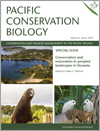
Pacific Conservation Biology
Volume 24 Number 4 2018
Special IssueConservation and Restoration in Peopled Landscapes in Oceania
PCv24n4_EDWhy I have come to care about conservation and restoration in peopled landscapes
PC18010Motivations for conservation action in peopled landscapes
We analysed biodiversity strategies and found that motivations for conservation in cities are primarily the benefits and services people gain from nature. However, case studies demonstrate how action in cities can generate considerable gains for wider conservation objectives; the challenge for planners is harnessing this energy for the best gains.
Restoring and enhancing biodiversity in urban areas is increasingly important as the extent of cities expands, and the proportion of people living in cities grows. Reintroductions could improve biodiversity by facilitating the establishment of urban tolerant species. We present the opinions of experts on suitable reintroduction candidates, restorations that might facilitate their establishment, and the limiting factors that need to be addressed.
PC18005Initiating a conflict with wildlife – the reintroduction and feeding of kākā, Wellington City, New Zealand
The reintroduction and feeding of kākā (Nestor meridionalis) in Wellington City, New Zealand, initiated a human–wildlife conflict. Feeding increases damage by kākā and caused attitudes to the birds amongst neighbours to diverge. The human dimensions of wildlife reintroductions, especially to cities, require greater pre-emptive consideration.
PC18013An overview of introduced predator management in inhabited landscapes
Knowledge of introduced mammalian predators in inhabited landscapes is scarce. We summarise key issues from the natural and social sciences in the management of introduced mammalian predators in inhabited landscapes of Aotearoa–New Zealand. We make recommendations for further research on the basic population biology of predators in inhabited landscapes, and for more long-term studies.
PC17055Using community engagement and biodiversity surveys to inform decisions to control invasive species: a case study of yellow crazy ants in Atafu, Tokelau
We report on the factors influencing the decision to control yellow crazy ants in Atafu, Tokelau. A combination of biodiversity impact surveys, measures of abundance of the ant invader, and surveys of peoples’ opinions all supported the benefit of undertaking control.
PC17059More than just the animals: opportunities and costs of reintroducing threatened black-footed rock-wallabies to remote Indigenous land
 , Magdalena Zabek, Carolina Galindez-Silva, Sara Weir, Rebecca West, Liberty Olds, Brett Backhouse, Peter Copley and John Read
, Magdalena Zabek, Carolina Galindez-Silva, Sara Weir, Rebecca West, Liberty Olds, Brett Backhouse, Peter Copley and John Read
Indigenous-managed land occupies over 20% of the Australian landmass, containing ecosystems and species of considerable conservation value. We evaluate a reintroduction of the threatened black-footed rock-wallaby in the Anangu Pitjantjatjara Yankunytjatjara Lands of north-western South Australia, including a review of the finance and labour costs incurred, and conclude that reintroductions on Indigenous-managed land can provide considerable conservation and social outcomes.
PC17058Conservation challenges and benefits of multispecies reintroductions to a national park – a case study from New South Wales, Australia
We outline the challenges and benefits associated with the establishment phase of a mammal reintroduction project on government-managed land. The legislative, policy, social and institutional challenges for such a project in Sturt National Park in arid Australia are explored, providing lessons for similar large-scale restoration and reintroduction projects
PC18072Conservation and restoration in peopled landscapes in Oceania: opportunities and challenges
 , Victor Anton, Monica A. M. Gruber
, Victor Anton, Monica A. M. Gruber  , Luke Ireland
, Luke Ireland  , Wayne Linklater
, Wayne Linklater  , James C. Russell and Danielle F. Shanahan
, James C. Russell and Danielle F. Shanahan 
In this paper we synthesise key findings from our special issue on conservation and restoration in peopled landscapes in Oceania.
PC18042Coal grunters shift benthic objects to access macroinvertebrates in a headwater stream
Few fishes have been documented shifting objects to access prey. Coal grunters were observed using the mouth, snout or nape to lift, flip or roll benthic objects and expose benthic macroinvertebrates during a series of daytime snorkelling sessions in a clear, sandy upland tributary of the Mitchell River, northern Queensland, Australia.
PC18040Coral colonies in the eastern tropical Pacific: predation by Acanthaster cf. solaris
The crown of thorns (CoTS; Acanthaster cf. solaris) have not been reported as an actual threat to reefs in the Gulf of California; however, in the Espiritu Santo Archipelago National Park, we have evidenced massive predation over scleractinian corals. Its abundance is now over outbreaks threshold value and it is higher than historical records



